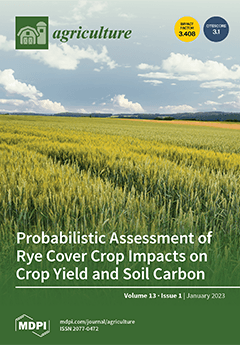Zero Budget Natural Farming (ZBNF), utilizing natural resources, multiple cropping systems, and cow-dung- and urine-based products to improve soil biology, has been practiced by thousands of farmers in India. However, without any scientific proof, this traditional and ancient technique is mocked as a
[...] Read more.
Zero Budget Natural Farming (ZBNF), utilizing natural resources, multiple cropping systems, and cow-dung- and urine-based products to improve soil biology, has been practiced by thousands of farmers in India. However, without any scientific proof, this traditional and ancient technique is mocked as a bugged theory in the scientific community. In the current study, we have investigated the effect of
Jeevamrit—cow-dung- and urine-based formulation—on soil chemical and microbial properties of the ZBNF field coupled with metagenomic analysis and the economics of ZBNF. The percentage increase in soil properties, such as organic carbon, available phosphorus, and available potassium, was recorded up to 46%, 439%, and 142%, respectively, while micronutrients, such as Zn, Fe, Cu, and Mn, also increased up to 98%, 23%, 62%, and 55%, respectively, from 2017 to 2019. Whole genome metagenomic analysis revealed that Proteobacteria were dominantly present, and bacterial phyla including
Bacillus,
Pseudomonas,
Rhizobium, and
Panibacillus. On the other hand, Ascomycota was the dominating fungal phyla present in the soil sample. Further, functional analysis showed a high representation of genes/enzymes involved in amino acids and carbohydrate metabolism contributing to soil fertility, plant growth, defense, and development. Additionally, the cost–benefit ratio of ZBNF was double the farmer’s practice when tested with the rice and wheat cropping system. The results from this study provide a new proof of concept and understanding of the potential of the ZBNF component, i.e.,
Jeevamrit, in improving soil properties.
Full article





